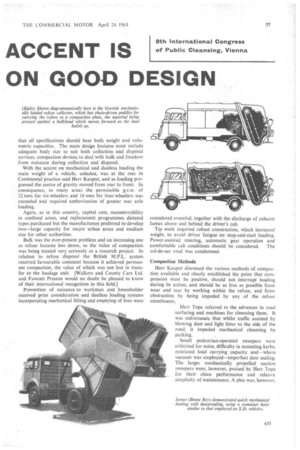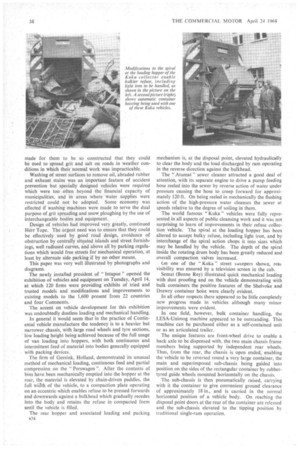ACCENT IS ON GOOD DESIGN
Page 59

Page 58

Page 60

If you've noticed an error in this article please click here to report it so we can fix it.
THE lith Internalional Congress of Public Cleansing held in Vienna last week was widely attended by representatives from all parts of the world, including many strong British and American contingents. Of particular interest to readers of The Commercial Motor were three of the papers, and the vehicles and equipment shown at an excellently staged exhibition. Early papers were given by Mr. Alan Barton, general manager of the Birmingham salvage department and Mr. Sundqvist, director of public cleansing, Stockholm, on "Labour Relations in Public Cleansing" which clearly indicated the values placed upon the provision of well-designed vehicles and equipment in easing the task of employees, providing good working conditions, and in combining operational efficiency with economy.
Mr. Barton especially referred to changes which had taken place since the days of horse-drawn and solid-tyred motor vehicles when men rode to and from work "in the load ", or walked, and made special reference to the vast improvement in working conditions with modern vehicles with low loading lines and dustless or semi-dustless loading equipment. The ability to handle bulk containers with specially-designed lifting equipment was a welcome and comparatively recent feature, he said.
Following, Mr. Sundqvist spoke of the improved work rates resulting from the initiation of piece-rate work and gave many examples of the value of specialist and speciallyequipped vehicles in Stockholm in all phases of a cleansing department's work.
A feature not common in the U.K., was the use of instrumentation in control of mechanical street sweepers and gully emptier, said Mr. Sundqvist. In the former case time, speed and distance, both travelling and sweeping, were recorded. In the latter these features were repeated n32 and the number of times the tank was filled was recorded through a meter.
Transfer stations figured in the removal of refuse from the whole of Stockholm to an incinerator plant 20 km. to the west of the city centre, he continued, but bulk haulage was effected by rail and not road, and packing of rail wagons achieved by a tractor fitted with an hydraulically operated tamping arm adding about 2-6 tons per load to each rail car compared with normal loading.
By far the most remarkable degree of mechanization in Stockholm, however, was related to snow clearance and the treatment of icy paved areas went on Mr. Sundqvist. In 1939 about 6,000 men were normally used on this work; today the department's 600 men were, when necessary, supplemented by 400 men from other departments and casual employees as a result of equipping 650 vehicles for ploughing and loading, and 275 vehicles for sanding operations. Vehicles hired and equipped with municipallyowned appliances were about 70 per cent of the total number.
Modern vehicles and equipment in Germany Herr W. Kauput (Frankfurt-am-Main) and Herr O. Tope (Hanover) fully described vehicles and equipment in use for public cleansing services in Germany. The essential differences in Continental practices were marked in comparison with British thought.
Herr Kauput dealt especially with refuse collection, and Herr Tope with Street cleansing and its associated functions.
It was clear that as in this country, design *as based upon specialist vehicles for domestic and most types of trade refuse but that the bulky objects such as beds, furnishings and so on were dealt with by standard vehicles. The theory was advanced, however, and usefully, that all specifications should bear both weight and volumetric capacities. The main design features must include adequate body size to suit both collection and disposal services, compaction devices to deal with bulk and freedom from nuisance. during collection and disposal.
With the accent on mechanical and dustless loading the main weight of a vehicle, unladen, was at the rear in Continental practice said Herr Kauput, and as loading progressed the centre of gravity moved from rear to front. In consequence, in many areas the permissible g.v.w. of 22 tons for six-wheelers and 16 tons for four-wheelers was exceeded and required authorization of greater rear axle loading.
Again, as in this country, capital cost, manceuvrability in confined areas, and replacement programmes dictated types purchased but the manufacturers preferred to develop two—large capacity for major urban areas and medium size for other authorities.
Bulk was the ever-present problem and an increasing one as refuse became less dense, so the value of compaction was being treated very seriously as a research project. In relation to refuse disposal the British M.P.L. system received favourable comment because it achieved permanent compaction, the value of which was not lost in transfer to the haulage unit. [Walkers and County Cars Ltd. and Fawcett Preston would no doubt be pleased to know of their international recognition in this field.] Prevention of nuisance to workman and householder received prior consideration and dustless loading systems incorporating mechanical lifting and emptying of bins were considered essential, together with the discharge of exhaust fumes above and behind the driver's cab.
Tip work required robust construction, which increased weight, to avoid driver fatigue on stop-and-start loading. Power-assisted steering, automatic gear operation and comfortable cab conditions should be considered. The cul-de-sac road was condemned.
Compaction Methods Herr Kauput discussed the various methods of compaction available and clearly established the point that compression must be positive, should not interrupt loading during its action, and should be as free as possible from wear and tear by working within the refuse, and from obstruction by being impeded by any of the refuse constituents, Herr Tope referred to the advances in road surfacing and machines for cleansing them. It was unfortunate that whilst traffic assisted by blowing dust and light litter to the side of the road, it impeded mechanical cleansing by parking.
Small pedestrian-operated sweepers were criticized for noise, difficulty in mounting kerbs, restricted load carrying capacity and--where vacuum was employed—imperfect dust sealing. The larger mechanically propelled suction sweepers were, however, praised by Herr Tope for their clean performance and relative simplicity of maintenance. A plea was, however, made for them to be so constructed that they could be used to spread grit and salt on roads in weather conditions in which their normal work was impracticable.
Washing of street surfaces to remove oil, abraded rubber and exhaust stains was an important feature of accident prevention but specially designed vehicles were required which were too often beyond the financial capacity of municipalities, and in areas where water supplies were restricted could not be adopted. Some economy was effected if washing machines were made to serve the dual purpose of grit spreading and snow ploughing by the use of interchangeable bodies and equipment.
Design of vehicles had improved very greatly, continued Herr Tope. The urgent need was to ensure that they could be effectively used by good road design, avoidance of obstruction by centrally situated islands and street furnishings, well radiused curves, and above all by parking regulations which would free streets for mechanical operation, at least by alternate side parking if by no other means.
This paper was very well illustrated by photographs and diagrams.
The newly installed president of " Intapue " opened the exhibition of vehicles and equipment on Tuesday, April 14, at which 120 firms were providing exhibits of tried and trusted models and modifications and improvements to existing models to the 1,600 present from 22 countries and four Continents.
The accent on vehicle development for this exhibition was undoubtedly dustless loading and mechanical handling.
In general it would seem that in the practice of Continental vehicle manufacture the tendency is to a heavier but narrower chassis, with large road wheels and tyre sections, low loading height being achieved because of the full usage of van loading into hoppers, with both continuous and intermittent feed of material into bodies generally equipped with packing devices.
The firm of Geesink, Holland, demonstrated its unusual method of mechanical loading, continuous feed and partial compression on the " Perswagen ". After the contents of bins have been mechanically emptied into the hopper at the rear, the material is elevated by chain-driven paddles, the full width of the vehicle, to a compaction plate operating on an eccentric which enables refuse to be pressed forwards and downwards against a bulkhead which gradually recedes into the body and retains the refuse in compacted form until the vehicle is filled.
The rear hopper and associated loading and packing B34 mechanism is, at the disposal point, elevated hydraulically to clear the body and the load discharged by ram operating in the reverse direction against the bulkhead.
The " Atumat " sewer cleaner attracted a good deal of attention, with its separate engine to drive a pump feeding hose reeled into the sewer by reverse action of water under pressure causing the hose to creep forward for approximately 120 ft. On being reeled in mechanically the flushing action of the high-pressure water cleanses the sewer at speeds relative to the degree of soiling in them.
The world famous " Kuka " vehicles were fully represented in all aspects of public cleansing work and it was not surprising to learn of improvements in their refuse collection vehicle. The spiral at the loading hopper has been altered to accept bulky refuse, including light iron, and by interchange of the spiral action chops it into sizes which may be handled by the vehicle. The depth of the spiral inside the rotating drum body has been greatly reduced and overall compaction valves increased.
On one of the " Kuka " street sweepers shown, real visibility was ensured by a television screen in the cab.
Semat (Benne Rey) illustrated quick mechanical loading with dust proofing and on the vehicle demonstrating with bulk containers the positive features of the Shelvoke and Drewry container hoist were clearly evident.
In all other respects there appeared to be little completely new progress made in vehicles although many minor improvements were evident.
In one field, however, bulk container handling, the LESA-Unimog machine appeared to be outstanding. This machine can be purchased either as a self-contained unit or as an articulated trailer.
The unique features are front-wheel drive to enable a back axle to be dispensed with, the two main chassis frame members being supported by independent rear wheels. Thus, from the rear, the chassis is open ended, enabling the vehicle to be reversed round a very large container, the main and superimposed sub-chassis being guided into position on the sides of the rectangular container by rubbertyred guide wheels mounted horizontally on the chassis.
The sub-chassis is then pneumatically raised, carrying with it the container to give convenient ground clearance of approximately 18 in., and is carried in the normal horizontal position of .a vehicle body. On reaching the disposal point doors at the rear of the container are released and the sub-chassis elevated to the tipping position by traditional single-ram operation.




















































































































